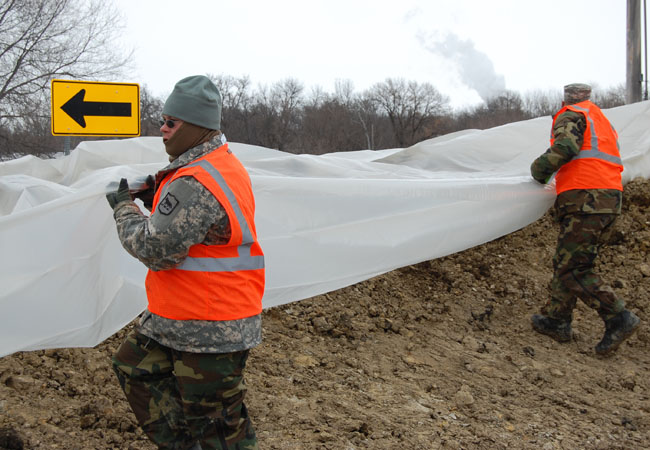Plastic and potatoes help protect earthen dikes
by Tom Robertson, Minnesota Public Radio
March 30, 2009
A spring storm has already started to deliver snow to the Fargo-Moorhead area, with up to a foot of snow expected. The winds will also pick up, and that will complicate efforts to hold back flooding on the Red River. Officials say the 30 mph winds could whip up waves and threaten the integrity of the dikes built to protect both cities. Today, the U.S. Army Corp of Engineers began covering vulnerable sections of the dikes with huge sheets of plastic to protect them from erosion.

Fargo, N.D. " National Guard troops pull huge sheets of plastic over an earthen dike that protects this east Fargo neighborhood.
Army Corps of Engineers spokesman Frank Worley says they're building a makeshift protective layer to keep the waves from eroding the soil. The worry is that water could crash into the dike and cause breaches.
"This was engineered on the fly, literally, over the last 24 hours. We knew we needed a solution for the possible wave action," said Worley.
Engineers knew they had to lay down the plastic cover over about 300 feet of this dike, but they weren't sure how they'd secure the covering to the sandbags that hold it down. Worley says they came up with a strange, creative solution.
"Someone suggested tennis balls, but they didn't have any available, and another person said 'Hey, why not potatoes?'" said Worley. "We'll take the potato, wrap a little bit of the poly around it so it will create sort of a bulge or joint, like your elbow or a fist, and then wrap the rope around that bulge and use that to hold the sandbags in place."
For now, the Army Corps is using this technique only on the Fargo side of the river, because the direction of the prevailing winds during the storm will affect the North Dakota side more.
The Red River has already flooded a community golf course that's behind this dike. Grace Backman, who lives in the neighborhood behind the dike, says she's worried about what high winds could do.
"You don't have to be around water too long before you realize its power, and the wind will just magnify its power and its strength," said Backman. "The dikes are manmade, and we know that when we as man mess with Mother Nature, we don't often win. Maybe this time we will."
The Fargo-Moorhead communities had a blizzard last week as they began their battle against the flooding Red River.
Jill Graveline lives just across the street from the dike. She's not worried about the dike failing, but she says the heavy snow and wind will make life miserable for those fighting the flood.
"I'm most concerned about the men that are going to be out patrolling the dikes and working on the dikes," said Graveline. "Blizzards are not fun to be out in even if you're out for a minute. But to be out for 24 hours or 48 hours, it's going to be tough for them, I'm sure."
The huge snowfall to the south of Fargo-Moorhead will eventually make its way into the Red River. But at least for the short term, Mike Hudson of the National Weather Service says that won't pose a problem for people battling the flood.
Larger view
Moving more sandbags into place
"The river forecast center in Chanhassen will be looking at that ... and try to start modeling that for when we do get snow melt later in the month," said Hudson. "But for now that snow will lock in, and will not have a dramatic or even really an impact whatsoever, on the immediate river levels. They'll continue to fall."
Across the river in Moorhead, city officials say many of their sandbag dikes already have plastic wrapped around them. But the ones that don't could be vulnerable if winds create a lot of wave action.
Moorhead Mayor Mark Voxland says water levels of the Red River have been falling for several days, but strong winds could make the water rise.
"Wind blowing over a large body of water. ... It will pile up. The water will rise in front of the wind," said Voxland. "As placid as water seems, it is a very insidious enemy. It's an evil substance when it's at this height, and it's doing its best to beat us as much as we're doing our best to beat it in this crazy fight."
For now, people in Fargo-Moorhead are preparing -- for potential leaks in the levees and certain blizzard conditions. The worst of the storm is expected to wrap up late Tuesday.